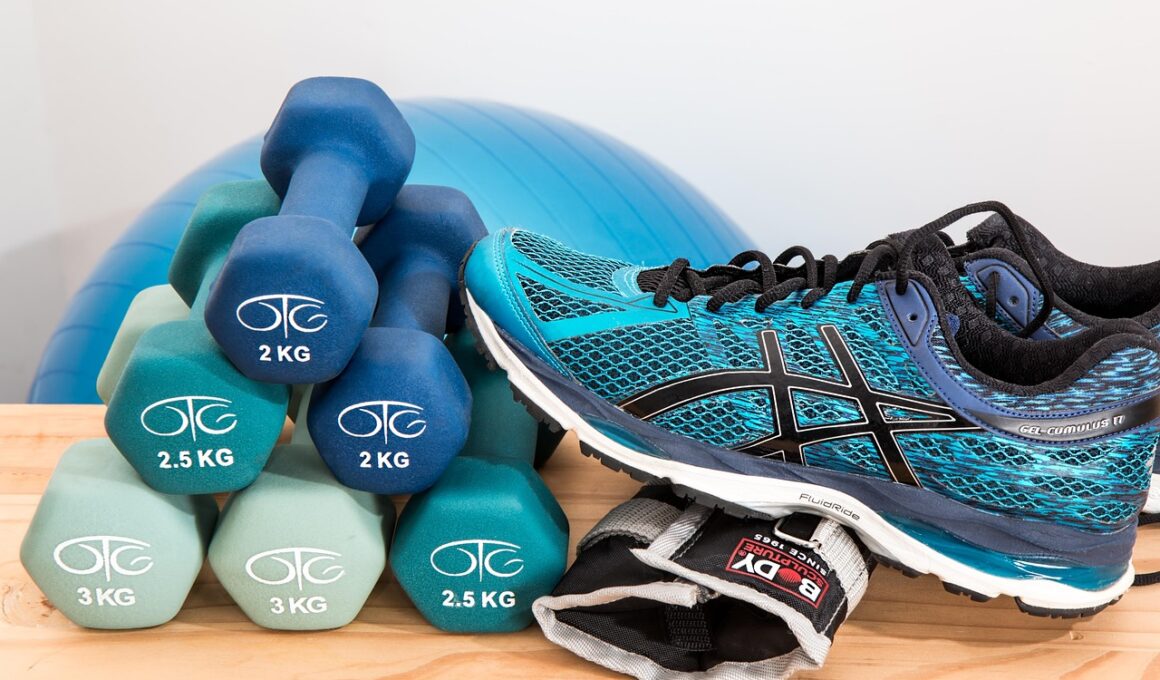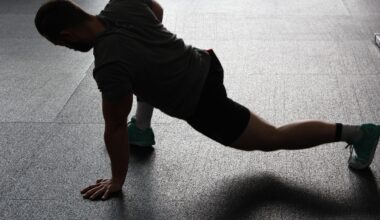The Role of Physical Activity in Managing Peripheral Artery Disease
Peripheral Artery Disease (PAD) is a condition characterized by narrowed arteries, leading to reduced blood flow, primarily affecting the lower limbs. This disorder can cause debilitating symptoms, including leg pain during physical activity, referred to as claudication. Individuals with PAD are also at a higher risk for cardiovascular events. Engaging in regular physical activity has been shown to alleviate symptoms and improve quality of life. Exercise promotes better circulation, enhances strength, and increases stamina for daily activities. Tailored exercise regimes can help patients manage their conditions effectively. Health professionals recommend supervised exercise programs for optimal benefits, as these provide monitoring and targeted support. Activities such as walking, cycling, and resistance training are popular among those with PAD. Over time, consistent exercise can lead to improved walking distances and reduced discomfort during activities. It is essential for individuals to consult their healthcare providers to design safe and effective exercise plans considering their specific conditions and abilities. Making physical activity a regular part of life supports not only physical health but also improves emotional and mental well-being for those living with PAD.
Implementing an exercise program can be daunting for those newly diagnosed with PAD. Education plays a crucial role in motivating individuals to engage in physical activity. They should be informed about the benefits exercise provides, including enhanced blood circulation and reduced symptoms. Moreover, understanding that physical activity can improve their overall cardiovascular health is vital. Patients are encouraged to start slowly, gradually increasing their exercise duration and intensity under medical guidance. Walking, as a low-impact activity, is typically recommended because it can be adjusted to one’s pace and capability. Furthermore, participating in group exercises can foster motivation and camaraderie among peers facing similar challenges. Patients might find it helpful to set realistic and measurable goals to track their improvements over time. Regular follow-ups with healthcare providers can keep them accountable and adjust their exercise plans if needed. Another important aspect is to choose comfortable footwear that provides adequate support during workouts. It can prevent injuries and enhance the overall exercise experience. Techniques such as warm-ups and cool-downs are advisable to reduce the risk of injury in a structured exercise program for optimal safety and effectiveness.
Clinical Evidence Supporting Exercise in PAD Management
Research indicates that exercise therapy significantly improves symptoms of PAD. In a study involving claudication patients, individuals who participated in a structured exercise program were able to walk longer distances with less pain than those who did not. These findings collectively underscore the role of physical activity in optimizing outcomes for those with cardiovascular diseases. Data shows that a walking program can enhance functional capacity, decrease pain perception, and boost overall mobility. Clinical trials have also demonstrated that exercise could reduce the dependence on medications, thus lowering potential drug side effects and interactions. The American Heart Association supports exercise as a primary form of therapy, indicating it should be a focal point in managing PAD. Exercise interventions have consistently shown improvements in endothelial function, which is crucial in promoting vascular health. Enhanced endothelial function leads to improved blood flow, especially necessary in patients with conditions like PAD. Furthermore, regular physical activity has beneficial effects on comorbidities associated with PAD, such as hypertension and diabetes. These improvements not only help in managing PAD better but also contribute to an overall enhancement in life quality for affected individuals.
Patients with PAD often experience feelings of frustration and isolation. However, engaging in a supportive exercise environment can contribute to improved morale and social interaction. Group exercise programs, for instance, enable participants to share experiences and offer mutual encouragement. Connection with others going through similar struggles can alleviate stress and promote adherence to exercise programs. Providing emotional support along with physical activity can enhance motivation levels for individuals with PAD. Most communities have programs that encourage exercise participation among patients with chronic diseases. These programs typically focus on education, safety, and personal achievement. Furthermore, families and friends can play an essential role in supporting individuals to maintain their commitment to physical activity. By fostering an encouraging atmosphere at home, exercise becomes a shared responsibility. Friends and family can join in on walks, making it not just a physical activity, but a social occasion. Incorporating fun into these activities can make a significant difference in long-term adherence. Ultimately, it is crucial to create loving and motivating environments that empower PAD patients to sustain their exercise routines effectively.
Barriers to Physical Activity in PAD Patients
Despite knowing the benefits, many individuals with PAD face various barriers to engaging in regular physical activity. Pain during exercise is often a significant concern that deters people from initiating a workout routine. The fear of exacerbating symptoms may lead to inactivity, contributing to further complications in the condition. Lack of motivation and support can make exercising feel overwhelming and unmanageable. Many patients may also have preconceived beliefs about their limitations, viewing themselves as incapable of improving. Inadequate health literacy can hinder their understanding of how exercise could help manage their condition effectively. Transportation issues to reach exercise programs also pose significant challenges. Many patients lack access to facilities or structured support programs, making it tough to commit to physical activities. Financial constraints and limited insurance coverage for exercise programs can further deter individuals from seeking help. It is vital for healthcare providers to address these barriers through education and community resources. Utilizing local programs that focus on accessibility can benefit those living with PAD, helping them overcome the obstacles they may encounter in maintaining an active lifestyle.
Creating a long-term exercise plan requires careful consideration of various factors. First and foremost, it is essential to have consultations with healthcare providers. These consultations will help identify personalized exercise recommendations according to each patient’s specific needs. Different patients may have different levels of fitness or additional health concerns that influence their exercise capacity. Patients should be open-minded towards trying various forms of exercise to discover which activities they enjoy most; this will enhance their likelihood of maintaining engagement over time. Rotating between multiple exercise types can also alleviate boredom, making workouts feel fresh and exciting. Striking a balance between different training modalities — such as aerobic, resistance training, and flexibility exercises — can help create a well-rounded fitness routine. It is also necessary to schedule routine follow-ups with healthcare teams to assess progress and modify exercise plans as needed. Regular assessment helps ensure that patients remain motivated and continue to see tangible improvements in their condition. Knowing that they are making strides in their health can provide added motivation for them to stick to their routines consistently over the long term.
Conclusion: Encouraging a More Active Life with PAD
The impact of physical activity in managing Peripheral Artery Disease cannot be overstated. By actively engaging in well-structured exercise programs, individuals not only manage their symptoms but also enjoy substantial improvements in their overall health and well-being. Partnerships between patients and healthcare providers can focus on developing personalized exercise plans that take into account individual capabilities and preferences. Overcoming barriers to physical activity, such as pain and lack of support, is essential to facilitate ongoing engagement in exercise. Empowering patients through education and community support leads to meaningful change. Ultimately, making physical activity a priority can enable those with PAD to lead healthier, happier lives, characterized by independence and vitality. Lives can be transformed through consistent, enjoyable physical activities that are tailored to meet their unique needs. The journey to recovery and management is a shared responsibility that encourages accountability, enriching the relationship between patients and their healthcare providers. Committing to regular exercise is a step towards a brighter future for individuals managing PAD, ensuring they do not have to face their challenges alone.
By fostering a rich culture of physical activity and well-being, communities can contribute tremendously to supporting individuals with PAD. Motivational programs can inspire not just patients but also healthcare professionals to advocate for healthier lifestyles. The community role in supporting patients can create a stronger sense of belonging and encouragement. Regular workshops, education sessions, and health fairs focused on exercise and cardiovascular health can further instill the importance of movement in daily life. Establishing community exercise groups or partnerships with local gyms can provide patients with accessible resources and environments to pursue their fitness goals. This community-driven approach fosters resilience among individuals facing PAD challenges. Each step becomes easier to take when one is part of a supportive network committed to positive lifestyle changes. The integration of physical activity within daily routines is achievable for those with PAD if embraced collectively. With the right encouragement, knowledge, and support systems in place, the journey to better health through exercise remains attainable. Striving for a more active lifestyle goes hand in hand with fighting against the challenges posed by Peripheral Artery Disease for a more fulfilling life.


